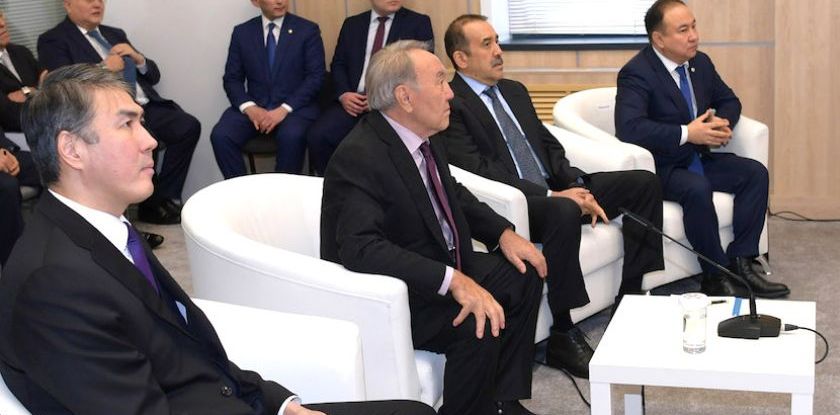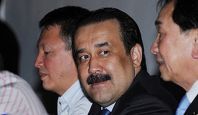In our recently-published article A Test for Mightiness, we have drawn the readers’ attention to the fact that Nursultan Nazarbayev had moved National Welfare Fund Samruk-Kazyna away from the direct subordination to the government and now wants to transform it into an extra-constitutional economic body directly subordinated to him.
This initiative seems all the more significant after January 18, 2019, when Nursultan Nazarbayev, in the course of his visit to Smart Aqkol, indicated in what way he wished to govern the country. Here is what he said according to Tengrinews.kz.
“The task that I have always visualized is to manage Kazakhstan as they manage a company or enterprise, from a single center. Here you have concentrated management, and everyone acknowledges it as an advantage. It is not an idle talk of who will do what and where but a vertical, concrete, rigid control that gives good results in the economic and other ways”, says Nazarbayev”.
These, in our opinion, quite sincere albeit offensive to many words are now being discussed rather actively on social media. Note that Akorda’s official website presents the President’s words in a more correct, smooth version. Here is a quote.
“I have always pursued the task of ensuring the efficient governance of the state. The concentrated management decisions provide good results for the economy”, said Nursultan Nazarbayev”.
Unfortunately, a word spoken is past recalling. Therefore, we confirm our predictions.
Presidential Decree 816 of December 27, 2018 “On the Changes to Presidential Decree 1116 of December 6, 2010 on the Samruk-Kazyna National Welfare Fund Management Council” is no ordinary red-tape document. It is a strategic plot to transform Samruk-Kazyna into the tool with which Nursultan Nazarbayev will personally try to solve the tasks related to the development and improvement of the national economy whilst the government will be left in charge of handling the routine operations.
We do not know who the author of this idea is. Most likely, as per Kazakhstan’s usual practice, it was a result of the combined efforts of many people guided by different motivations. But it is Nursultan Nazarbayev and his nephew Akhmetzhan Esimov appointed the Head of Samruk-Kazyna on December 23, 2017, that will become the main beneficiaries of the initiative.
In our opinion, in the course of the past two years, Nazarbayev has been trying to redesign the authoritarian political system and the super-Presidential vertical both of which have generally become obsolete and turned into a suitcase without a handle (difficult to carry but hard to part with it). However, since his main task for today and tomorrow is not only to hold on to the power but also not to allow for its weakening, the President is in no position to conduct any political reforms apart from the purely decorative ones.
In other words, the irreplaceable President must act in an extremely limited space. Presumably, it is for this reason that he has decided to attempt some kind of “perestroika” in order to enhance the competition inside the local elite and the state apparatus. In doing so, he is probably hoping to force his allies and subordinates to move with more energy and achieve good results while not forgetting that they are always under the control of the Leader of the Nation himself.
For the past two years, in the course of implementing these intentions, the Presidential Administration has been divided into two independent agencies – the actual Administration and the Security Council. Note that the latter, thanks to the latest legislative amendments, has become a constitutional authority.
Now Samruk-Kazyna has received the same kind of independence from the government. What is important is that both the Security Council and the Samruk-Kazyna Management Council are chaired by the President personally.
Since Nursultan Nazarbayev possesses a practically limitless power, we can safely assume that the consulting advisory status of these agencies is nothing but a smokescreen designed to draw attention away. Thus, inside of the state mechanism, the President is designing something that, de-facto, closely resembles a political opposition in its tasks and authorities, the opposition that, at the same time, exists under the direct control of the President himself.
It is important to note that this is not the first and probably not the last attempt of this kind in the post-Soviet history. Suffice it to recall the oprichnina of the times of Ivan the Terrible. The thing is, of course, that such actions bring only temporary results. Moreover, as a rule, they lead to the disorganizing of the state apparatus while allowing for the implementation of the “divide et impera” principle to the fullest.
So, we will observe how Nursultan Nazarbayev launches and employs the mechanism of the internal state competition with great interest. We will also follow its consequences since we highly doubt that, in the Kazakh context, the initiative is to bring positive results. Rather, it may serve as yet another reason for escalating the conflict among the elite.






